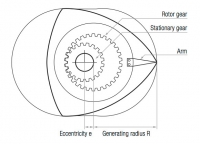Skip to comments.
DRILL A SQUARE HOLE?
My Photobucket ^
| October 19, 2011
| swampsniper
Posted on 10/19/2011 5:50:54 AM PDT by SWAMPSNIPER
This is cool!
TOPICS: Chit/Chat; Education; Miscellaneous; Science
KEYWORDS: drill; technology
Navigation: use the links below to view more comments.
first previous 1-20, 21-40, 41-51 last
To: SWAMPSNIPER
Definitely cool. I wonder what motion the chuck has to travel through to get the tip of the triangular cutter to folllow the square path. The sound of the milling machine doesn’t sound too good; I’m guessing due to the mechanism creating that odd motion.
It looks like chip ejection will be a problem with deep holes as there are no spiral flutes on the cutter.
Seems to be best suited for shallow, blind square holes.
To: tacticalogic
The machine does not rotate on a single axis so it is not a drill in the regular sense. It is more like a mill than a drill or a combination of the two.
42
posted on
10/19/2011 8:06:30 AM PDT
by
OldEagle
To: SWAMPSNIPER
Neat! I wonder if it would work without a pilot hole.
43
posted on
10/19/2011 8:26:04 AM PDT
by
JimRed
(Excising a cancer before it kills us waters the Tree of Liberty! TERM LIMITS, NOW AND FOREVER!)
To: JimRed
It doesn’t look like it would.
44
posted on
10/19/2011 8:32:40 AM PDT
by
SWAMPSNIPER
(The Second Amendment, a Matter of Fact, Not a Matter of Opinion)
To: Big_Harry; All
45
posted on
10/19/2011 9:12:23 AM PDT
by
az_gila
To: az_gila
I am much relieved to know that American ingenuity still shines forth!
46
posted on
10/19/2011 10:46:00 AM PDT
by
Big_Harry
(Ecc10:2 "A wise man's heart is at his right hand; but a fool's heart at his left")
To: chrisser
Wouldn't a square broach work just as well and take less time? Not in a blind hole, nor a through hole that prevents the broach from passing all the way through (a hole thru a pipe wall from od to id).
Regards,
GtG
47
posted on
10/19/2011 12:00:50 PM PDT
by
Gandalf_The_Gray
(I live in my own little world, I like it 'cuz they know me here.)
To: bigbob
same principle as a mortising bit, the square corners are cut with a broaching or chisel action. No, it's more like a single point shaper or planer cutter (metal not wood). The process is similar to hobbing a gear tooth profile, although the tool path motion is generated by an eccentric gear arrangement similar to the rotor of a Wankel engine. Of course the cutter drive uses a different ratio and eccentricity to generate a square rather then the "bean" shaped contour of the Wankel combustion chamber.

Regards,
GtG
48
posted on
10/19/2011 12:43:17 PM PDT
by
Gandalf_The_Gray
(I live in my own little world, I like it 'cuz they know me here.)
To: Johnny B.
"weird, sort of triangular holes...."
I'm betting they looked something like this, eh?:
To: ProtectOurFreedom
“I wonder what motion the chuck has to travel through to get the tip of the triangular cutter to folllow the square path.”
See my reply #49. If the tip is based on a reuleaux triangle, like I suspect, it should take only a simple circular path to trace out a square.
To: Boogieman
Hadn’t heard of that geometrical shape before. In your animation, it doesn’t quite make it to the corners. How would they address that?
Navigation: use the links below to view more comments.
first previous 1-20, 21-40, 41-51 last
Disclaimer:
Opinions posted on Free Republic are those of the individual
posters and do not necessarily represent the opinion of Free Republic or its
management. All materials posted herein are protected by copyright law and the
exemption for fair use of copyrighted works.
FreeRepublic.com is powered by software copyright 2000-2008 John Robinson

